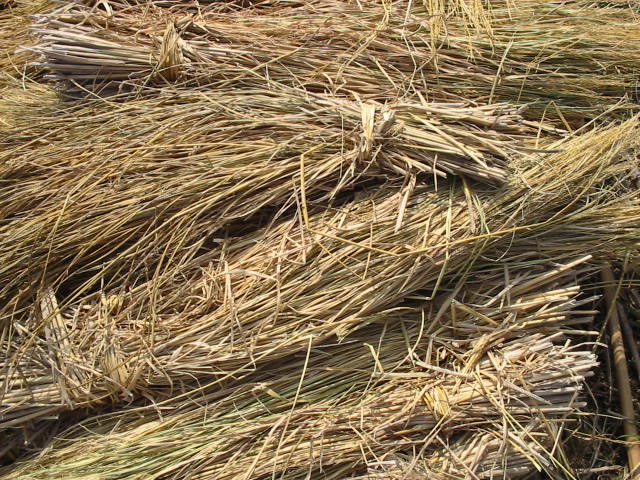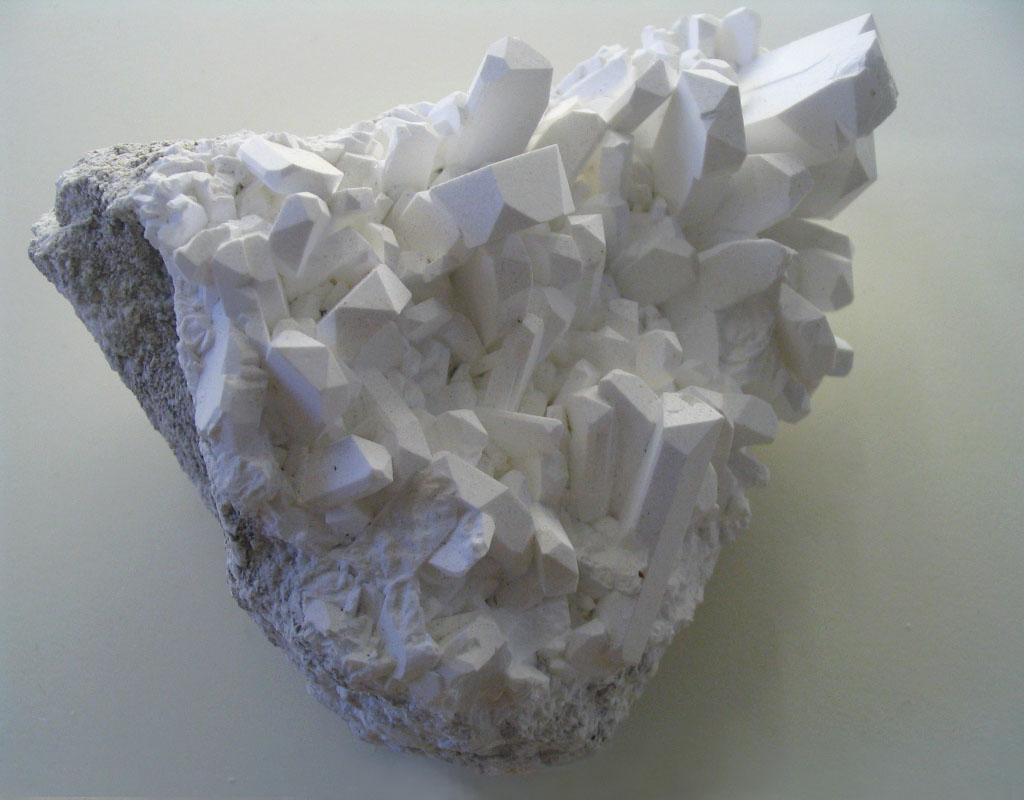|
Oriented Structural Straw Board
Oriented structural straw board (OSSB) is an engineered board that is made by splitting straw and formed by adding methylene diphenyl diisocyanate (MDI) and then hot compressing layers of straw in specific orientations. Research and development for OSSB panels began in the mid 1980s and was spearheaded by the Alberta Research Council, Canada (today AITF). Uses OSSB can replace wood oriented strand board (OSB) and particle board in structural and non-structural applications, such as interior and exterior walls for house construction, furniture and interior decoration. OSSB panels are formaldehyde-free, they are also used for applications where air quality is a concern, such as kindergartens, hospitals, bedrooms, and hotels. Manufacturing OSSB panel manufacturing starts with careful selection of straw fibres, which are then cut, cleaned, split and dried. Splitting straws allows resin to coat what would otherwise be the inside of a hollow straw. Producing split straw of sufficient ... [...More Info...] [...Related Items...] OR: [Wikipedia] [Google] [Baidu] |
Straw
Straw is an agricultural byproduct consisting of the dry wikt:stalk, stalks of cereal plants after the grain and chaff have been removed. It makes up about half of the crop yield, yield by weight of cereal crops such as barley, oats, rice, rye and wheat. It has a number of different uses, including fuel, livestock bedding and fodder, thatching and basket making. Straw is usually gathered and stored in a straw bale, which is a wikt:bale, bale, or bundle, of straw tightly bound with twine, wire, or string. Straw bales may be square, rectangular, star shaped or round, and can be very large, depending on the type of baler used. Uses Current and historic uses of straw include: Animal feed Straw may be fed as part of the roughage component of the diet to cattle or horses that are on a near maintenance level of energy requirement. It has a low digestible energy and nutrient content (as opposed to hay, which is much more nutritious). The heat generated when microorganisms in a h ... [...More Info...] [...Related Items...] OR: [Wikipedia] [Google] [Baidu] |
Methylene Diphenyl Diisocyanate
Methylene diphenyl diisocyanate (MDI) is an aromaticity, aromatic diisocyanate. Three isomers are common, varying by the positions of the isocyanate groups around the rings: 2,2′-MDI, 2,4′-MDI, and 4,4′-MDI. The 4,4′ isomer is most widely used, and is also known as 4,4′-diphenylmethane diisocyanate. This isomer is also known as Pure MDI. MDI reacts with polyols in the manufacture of polyurethane. It is the most produced diisocyanate, accounting for 61.3% of the global market in the year 2000. Production Total world production of MDI and polymeric MDI is over 7.5 million tonnes per year (in 2017). As of 2019, the largest producer was Wanhua Chemical Group. Other major producers are Covestro, BASF, Dow Chemical Company, Dow, Huntsman Corporation, Huntsman, Tosoh Corporation, Tosoh, Kumho Mitsui Chemicals. All major producers of MDI are members of the International Isocyanate Institute, whose aim is the promotion of the safe handling of MDI and Toluene diisocyanate, TDI ... [...More Info...] [...Related Items...] OR: [Wikipedia] [Google] [Baidu] |
Alberta Research Council
Alberta Innovates (AI) is a Canadian provincial crown corporation created and funded by the government of Alberta, responsible for promoting innovation in the province. Its appointed Board of Directors is accountable to the Minister of Jobs, Economy and Innovation. AI created from a variety of predecessor research and development organizations including the Alberta Research Council, the Alberta Heritage Foundation for Medical Research and the Alberta Energy Research Institute. History Scientific and Industrial Research Council of Alberta (SIRCA) In the early 1900s, Henry Marshall Tory, the first president of the University of Alberta, lobbied the Alberta government to create an organization to promote research and development (R&D) in the province. In 1921, the government created the Scientific and Industrial Research Council of Alberta (SIRCA). SIRCA was the first provincial R&D organization in Canada. SIRCA's initial mandate was " upportindustries in developing new resear ... [...More Info...] [...Related Items...] OR: [Wikipedia] [Google] [Baidu] |
Oriented Strand Board
Oriented strand board (OSB) is a type of engineered wood, formed by adding adhesives and then compressing layers of wood strands (flakes) in specific orientations. It was invented by Armin Elmendorf in California in 1963. OSB may have a rough and variegated surface with the individual strips of around , lying unevenly across each other, and is produced in a variety of types and thicknesses. Oriented strand board is sometimes confused with ''chipboard'', a synonym for particle board, whose "chips" are of a size that a lay person would likely describe as "particles". Uses OSB's mechanical properties make it suitable for load-bearing applications in construction. In North America, it is more popular than plywood, commanding 66% of the structural panel market in 2016. The most common uses are as sheathing in walls, flooring, and roof decking. For exterior walls, panels are available with a radiant-barrier layer laminated to one side; this eases installation and increases energ ... [...More Info...] [...Related Items...] OR: [Wikipedia] [Google] [Baidu] |
Particle Board
Particle board, also known as particleboard or chipboard, is an engineered wood product, belonging to the wood-based panels, manufactured from wood chips and a synthetic, mostly formaldehyde-based resin or other suitable binder, which is pressed under a hot press, batch- or continuous- type, and produced. Particle board is often confused with oriented strand board (OSB, also known as flakeboard, or waferboard), a different type of fiberboard that uses machined wood flakes and offers more strength. Characteristics Particle board is cheaper, denser, and more uniform than conventional wood and plywood and is substituted for them when cost is more important than strength and appearance. Particleboard can be made more appealing by painting or the use of wood veneers on visible surfaces. Though it is denser than conventional wood, it is the lightest and weakest type of fiberboard, except for insulation board. Medium-density fibreboard and hardboard, also called high-density fibe ... [...More Info...] [...Related Items...] OR: [Wikipedia] [Google] [Baidu] |
Formaldehyde
Formaldehyde ( , ) (systematic name methanal) is an organic compound with the chemical formula and structure , more precisely . The compound is a pungent, colourless gas that polymerises spontaneously into paraformaldehyde. It is stored as aqueous solutions (formalin), which consists mainly of the hydrate CH2(OH)2. It is the simplest of the aldehydes (). As a precursor to many other materials and chemical compounds, in 2006 the global production of formaldehyde was estimated at 12 million tons per year. It is mainly used in the production of industrial resins, e.g., for particle board and coatings. Formaldehyde also occurs naturally. It is derived from the degradation of serine, dimethylglycine, and lipids. Demethylases act by converting N-methyl groups to formaldehyde. Formaldehyde is classified as a group 1 carcinogen and can cause respiratory and skin irritation upon exposure. Forms Formaldehyde is more complicated than many simple carbon compounds in that i ... [...More Info...] [...Related Items...] OR: [Wikipedia] [Google] [Baidu] |
Volatile Organic Compounds
Volatile organic compounds (VOCs) are organic compounds that have a high vapor pressure at room temperature. They are common and exist in a variety of settings and products, not limited to house mold, upholstered furniture, arts and crafts supplies, dry cleaned clothing, and cleaning supplies. VOCs are responsible for the odor of scents and perfumes as well as pollutants. They play an important role in communication between animals and plants, such as attractants for pollinators, protection from predation, and even inter-plant interactions. Some VOCs are dangerous to human health or cause harm to the environment, often despite the odor being perceived as pleasant, such as " new car smell". Anthropogenic VOCs are regulated by law, especially indoors, where concentrations are the highest. Most VOCs are not acutely toxic, but may have long-term chronic health effects. Some VOCs have been used in pharmaceutical settings, while others are the target of administrative controls ... [...More Info...] [...Related Items...] OR: [Wikipedia] [Google] [Baidu] |
Borate
A borate is any of a range of boron oxyanions, anions containing boron and oxygen, such as orthoborate , metaborate , or tetraborate ; or any salt of such anions, such as sodium metaborate, and borax . The name also refers to esters of such anions, such as trimethyl borate . Natural occurrence Borate ions occur, alone or with other anions, in many borate and borosilicate minerals such as borax, boracite, ulexite (boronatrocalcite) and colemanite. Borates also occur in seawater, contributing to the absorption of low-frequency sound in seawater. Common borate salts include sodium metaborate (NaBO2) and borax. Borax is soluble in water, so mineral deposits only occur in places with very low rainfall. Extensive deposits were found in Death Valley and shipped with twenty-mule teams from 1883 to 1889. In 1925, deposits were found at Boron, California on the edge of the Mojave Desert. The Atacama Desert in Chile also contains mineable borate concentrations. Borates ... [...More Info...] [...Related Items...] OR: [Wikipedia] [Google] [Baidu] |
Oriented Strand Board
Oriented strand board (OSB) is a type of engineered wood, formed by adding adhesives and then compressing layers of wood strands (flakes) in specific orientations. It was invented by Armin Elmendorf in California in 1963. OSB may have a rough and variegated surface with the individual strips of around , lying unevenly across each other, and is produced in a variety of types and thicknesses. Oriented strand board is sometimes confused with ''chipboard'', a synonym for particle board, whose "chips" are of a size that a lay person would likely describe as "particles". Uses OSB's mechanical properties make it suitable for load-bearing applications in construction. In North America, it is more popular than plywood, commanding 66% of the structural panel market in 2016. The most common uses are as sheathing in walls, flooring, and roof decking. For exterior walls, panels are available with a radiant-barrier layer laminated to one side; this eases installation and increases energ ... [...More Info...] [...Related Items...] OR: [Wikipedia] [Google] [Baidu] |



